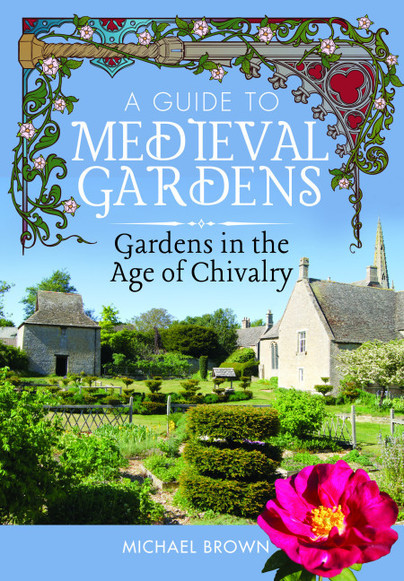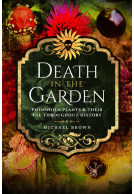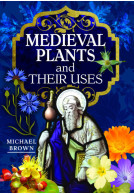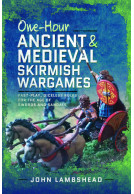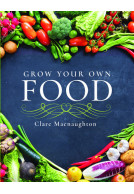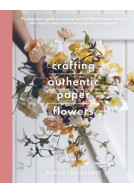A Guide to Medieval Gardens (Hardback)
Gardens in the Age of Chivalry
(click here for international delivery rates)
Need a currency converter? Check XE.com for live rates
| Other formats available - Buy the Hardback and get the eBook for £1.99! | Price |
|---|---|
| A Guide to Medieval Gardens ePub (30.3 MB) Add to Basket | £6.99 |
Medieval gardens usually rate very few pages in the garden history books. The general perception is still of small gardens in the corner of a castle. Recent research has shown that the gardens were larger than we previously believed. This book contains information and pictures that have not been generally available before, including the theory and practice of medieval horticulture. Many features of later gardens were already a part of medieval gardens. The number of plants was limited, but was still no less than many modern gardeners use in their own gardens today. Yet medieval gardens were imbued with meaning. Whether secular or religious, the additional dimension of symbolism, gave a greater depth to medieval gardens, which is lacking in most modern ones.
This book will be of interest to those who know little about medieval gardens and to those with more knowledge. It contains some of the vast amount of research that the author carried out to create the medieval gardens at the Prebendal Manor, Nassington, Northamptonshire. The author has tried to use previously unused sources and included his own practical experience of medieval gardening methods that he carried out to maintain the gardens. Some worked, others certainly didn’t.
A really interesting dive into the gardens of Medieval times. Very different styles and purpose from what we are used to today.
NetGalley, Kerrie Hoar
Gardens were fashionable in the 15th century, even for famous warrior Kings: and their retired physicians apparently. One of Henry’s former physicians had a garden at the Prebendal Manor in Nassington in Northamptonshire.
NetGalley, Joanna Arman
The later chapters about creating your own Medieval Garden will be more useful to others, but the parts about different plants, their uses and the social history surrounding gardens was very interesting.
I understand this same author has a book on Medieval plants and their uses, which should keep this Cadfael fan happy. This one is a lovely summary of the subject with some great photos and illustrations. I might take this with me next time I go to Weald and Download Museum which gets a section devoted to the 2 recreated Medieval gardens there.
Enjoyable and insightful, perfect for those who love both gardens and the medieval period.
NetGalley, Frankie Dannatt
I liked how easy this is to read, the chapters are well constructed and laid out making it very easy to jump in at any time. Some beautiful illustrations fit well with the writing and give a greater insight into the subject covered.
I really liked this one, I have a fondness for walking around old gardens and I was surprised just how the medieval era has impacted today's gardens.
A definite must-read for gardeners, garden lovers, and readers who love history and the medieval period, this will be a winner for everyone.
4 out of 5
Amazon Customer, Jayne
I knew little about medieval gardens or medieval gardening practices before reading this book with its very inviting cover. I found it fascinating that Michael Brown set out to create a small medieval garden but his years of research let to a much larger enterprise which sounds like a mission or even his life’s work.
I didn’t even know that gardening archaeology was a thing, but having just read a novel about garden archaeology in the later time around the gunpower plot The Winter Garden by Nicola Cornick, I was intrigued by this book too and the author’s research.
I find it fascinating that we are still planting the same plants today all of these years later, such as roses, irises, lilies.
The beliefs in planting depending on the position of the stars fascinated me. I’ve heard some of these practices described as old wives’ tales before, but never realised that they go so far back in history.
I wish the section on planting your own medieval garden had been a little longer, but I like the idea of planting plugs of flowers in my lawn. Very interesting book.
Beautifully illustrated, this is an attractive book which makes you want to pick it up. Nor does it disappoint, providing a fascinating read for the armchair gardener as well as the more practical variety. It has been written by someone who has got their hands dirty; the gardens at the Prebendal Manor, Nassington (Northants), are the result of the author’s
The Ricardian Bulletin, June 2022
research. The author draws on a wide range of sources: herbals, animal management, medieval manuals, illuminated manuscripts, account books, poems, paintings and tapestries.
The book is very interesting, well worth reading. I liked the details about the tools and the garden features. I did not realize how much there was to learn.
NetGalley, Elizabeth Brandimarte
Profusely and beautifully illustrated throughout, Professor Michael Brown's "A Guide to Medieval Gardens: Gardens in the Age of Chivalry" will be of particular interest to academia and non-specialist readers with an interest in the subject of medieval gardens. This very special history contains some of the vast amount of research that Professor Brown carried out to create the medieval gardens at the Prebendal Manor, Nassington, Northamptonshire. He had tried to use previously unused sources and included his own practical experience of medieval gardening methods that he carried out to maintain the gardens. Some worked, others certainly didn't.
Midwest Book Review
A simply fascinating read and a singularly important. informative, unique and welcome addition to personal, professional, community, college, and university library Medieval Studies and History of Gardening collections.
Read the full review here
A Guide to Medieval Gardens by Michael Brown is a very good guide indeed. It covers all sorts of aspects of medieval gardens, from what was considered to be a weed to how they were presented in artworks, what were the constituent features of these gardens, and even the tools they used.
Coffee and Books
There are so many pictures in the book, showing both gardens, but also tools, which were very helpful to create a clear picture of what was involved.
Read the full review here
A fascinating guide to medieval horticulture including information and pictures unseen before. It included all aspects such as the garden design & layout including limited plants & tools used.
NetGalley, Kelly Furniss
The meaning of the gardens was explained, inspired through symbolism either religious or secular.
A comprehensive guide is included of gardens to visit & the inclusion of drawings and photographs made it easy to imagine what some in the past were like.
A very interesting read for anyone interested in history & horticulture.
As featured in the article: 'Historic Gardener'
History Revealed
Rating: 5 out of 5 stars
NetGalley, Adam Waldron
Loved this book. It was very interesting to read the history of these gardens. There was enough information and illustration for me to have a go myself at recreating a mediaeval garden.
Rating: 5 out of 5 stars
NetGalley, Sophia Rose
As a lover of medieval history and gardens, I could not help snatching up a book that was devoted to both, by a person who brought to life a medieval garden. I was unsure of what to expect, but I anticipated whatever was to come.
A Guide to Medieval Gardens opens with an introduction to the author, his research, and an overview of the Medieval English world that explained the significance of what archeologists and researchers have discovered pertaining to gardens of that period. Gardens were for upper class pleasure and status symbols, but they were also as practical as could be providing for the household and those who lived in the castles, villages, and monasteries.
The book ‘visited’ several fine examples, mostly around England of what was left of medieval gardens, some archeological finds, and in archival pages the plottings of those gardens of the past and what could be found in them. It was fascinating to know what was grown in those gardens and ponds, but also how they were laid out and who used them. It is interesting to see the connection our modern gardens have to those in the past and what parts of our landscaping choices hail from that period.
There were some lovely graphics of pictures, drawings, and more liberally scattered through the book and a great deal of fascinating background not just on the gardens, but medieval life in general both secular and monastic. It was so vividly described I felt I was indeed on a guided tour as the title of the book suggests. I thought it was well researched and obvious the author knew of that which he was writing. I can definitely recommend this quick and easily read book to gardening and/or historical enthusiasts.
I really enjoyed reading this book, I learned a lot. Michael is superb at adding in fascinating bits of detail and this book is very hard to put down once you start reading it.
Blackberry Garden
Read the full review here
Rating: 5 out of 5 stars
NetGalley, Anna Maria Giacomasso
I never thought there was so much to learn about Medieval gardens and how fascinating it could be.
This is a fascinating book, a treat if you love garden and history.
It's well researched, informative and an excellent introduction to this topic.
I strongly recommend it.
A fascinating account of formal gardens during the middle ages. Will be of great interest to anyone with a penchant for stately homes and anyone with a general interest in gardening too. Beautifully illustrated.
Books Monthly
This book is very well written and laid out with lots of colour pictures of manuscripts, period images and photos of current medieval gardens.
Medieval Sword School
The book includes chapters around being a medieval gardener, the tools needed, the techniques used and how to make your own medieval garden. While I am not going to suggest we do this at home. This could make a great school project for those covering the medieval period.
The book also lays out a calendar of what tasks need doing during each month of the year so this is an easy to follow along guide to medieval gardening.
The book also has a list of medieval gardens you can visit today.
Read the full review here
Rating: 5 out of 5 stars
NetGalley, Randal White
Loved this book! It took two of my favorite things, gardening and history, and combined them masterfully. If you ever found yourself working in your garden, and wondered about why you were doing it the way you were, you might be surprised to learn people did the same tasks, the same way, hundreds of years ago!
The book had chapters on different types of medieval gardens, and the features you might find in each one. This was interesting.
But where the book really shined was in the description of gardener's tools and techniques. I found it fascinating. Along with how medieval gardeners used the calendar, tips on how they grafted and cultivated, and what plants they used.
There is one part that I would like to share from the book. "Sometimes, a little divine intervention may be required to keep pests under control. One of the most terrible things that could happen to a medieval person was to be excommunicated from the protection and comforts of the church. This punishment was not just reserved for people, it could also be used to clear pests". Bishops have excommunicated caterpillars, field mice, and snails. Why didn't I think of this? Going to put in a call to the minister to come over and excommunicate the darned slugs in my garden!
This is an interesting, informative, and fun read. If you like gardening, I think you will enjoy it.
As featured in
This England
Rating: 5 out of 5 stars
NetGalley, AJ Sefton
A beautiful combination of two of my greatest joys - gardens and all things Medieval. I've never come across a book that focuses on Medieval gardens alone before, so this book was a winner even before I'd opened it.
The book is broken down into sections such as the European influence, tools used in Medieval gardening, water features, the plants chosen, and the evidence used to identify Medieval gardens. The book concludes with two of my favourite things: the Medieval gardening year and how to create your own Medieval garden. The list of jobs is, of course, very similar to gardening jobs now, but in Medieval times it took on rituals aligned to the whole village.
Throughout, the book is illustrated with paintings and tapestries from the period, as well as beautiful photographs of gardens today, so if you have the choice, buy the hardback version so the pictures can be truly appreciated. These images though have been painted or created in Europe so there is some speculation or perhaps romanticism about the features of the gardens in Britain, especially considering that the flowers are shown flowering out of season.
There is a great mix of history and horticulture in this book. It is written in a very accessible way so the reader doesn't have to be a specialist in either field to thoroughly enjoy the read. Personally, I enjoyed reading about the castles I have visited and learning about the gardens that were there, like Tintagel Castle in Cornwall. So the book could serve as a traveller's guide too. As Medieval England was a deeply religious time, many gardens were created to honour the garden of Eden and contained much symbolism, so the gardens of abbeys, monasteries and churches are particularly fascinating.
A well-researched and informative book that will look good on anyone's shelf. Highly recommended to everyone interested in Britain.
*4.5 stars*
NetGalley, Diane Radtke
Leisurely stroll down the garden path…
For me, a casual gardener at best but an avid historical buff, I walked that path with pleasure. The author had created/built/brought to life his own interpretation of a medieval garden so who better talk on the subject. Broken into distinct topics – from historical to the present – it was part sleuthing and very much an ode to the enjoyment of gardening.
There was (and is) so much that makes up a garden. This book reflects that range as it talks about cultural and religious influences, architectural and design choices as well as the flowers, grasses, and trees (of course!). Included were sketches, purchasing records and anecdotal comments pulled from history and incorporated into this volume. Digesting these varied facts and influences fed into the author’s own modern and real-life interpretation of what a medieval garden might have been.
Presented in an easy, conversational way, this was informative as well as a very enjoyable read.
This is a well written and illustrated layman accessible book. The author provides a good overview over the (scant) extant historical records for the locations and aspects of medieval gardens associated with castles and monasteries in Britain and surrounding areas. It's well organized and easy to understand. The chapters are arranged thematically: historical records of medieval gardens, cultural influences, monastic and secular gardens, design, water features, parks, plants, gardeners, period tools, cultivation techniques, the gardener's seasonal calendar, and a very short tutorial guide with inspiration for modern gardeners to incorporate medieval features into their modern gardens.
NetGalley, Annie Buchanan
The book is peppered throughout with drawings, facsimile historical documents, illustrations from period illuminated books, and modern photographs of recreated gardens - many of which have historical recreators in period dress. The photos especially added a lot for me and made it easy to imagine what the original gardens must've been like.
This is a good general introduction. It's not a scholarly work, so there aren't any chapter annotations, but the author has included a fair number of website resources and period gardens and resources which are open (at least part time) to the public. There's an abbreviated bibliography which will also provide opportunities for further reading.
Four stars.
Rating: 5 out of 5 stars
NetGalley, Brenda Carleton
Gardening is difficult to imagine on this brutal -36C winter day. Nonetheless, this book transported me immediately to the beauty and practicality of gardening, namely in the medieval period. As a master gardener I look at many aspects of gardens yet had not thought enough about the the whys of depictions of gardens and plants through ancient art, such as idealized landscapes on tapestries. Fascinating information and gorgeous and compelling photographs abound in this book. The author also includes places where some gardens can be seen. I have had the fortune to visit some of them (Bodiam, Kenilworth, Tintagel) plus others outside of the UK. Well worth seeking out!
Gardens can be public and private, practical and strictly for pleasure. In this interesting look into history which begins with Biblical Eden the author describes the roles of fish ponds, deer parks, dovecotes and fountains in gardens and explains monastery gardens with their cloisters, decorated shrines and wells. Plants were...and are...used in creating colours and textiles. Evidence is not only found in art but also in documents and plans such as state expenses and pollen analysis.
This book is packed with details about garden tools used then, willow withies (which I see in the Mediterranean), pest control, fertilizers and an intriguing story about Constantine IX. Tree arbours, pattens, vineyards, moats and turf seats are detailed. But there is so much more.
Gardeners and historians alike have reason to fall in love with this gorgeous book but you needn't be either to appreciate it.
My sincere thank you to Pen & Sword and NetGalley for the privilege of reading this fabulously rich and educational book! It has changed the way I will view art and literature in this manner from now on.
Informative book. I was familiar with coppiced trees, but had no idea they dated back so far. Also, turf seats sound so interesting. I always assumed gardens were only kept for food and herbs and decorative gardens didn't develop until the 18th century. It was amazing to learn that topiaries developed so early in history. Quite a bit of research went into writing this book and as a gardener, I enjoyed reading about the discoveries. Gardeners will likely enjoy this book, it's not too technical and the history of gardens is always of interest!
NetGalley, Catherine Hankins
Some people enjoy gardening and some people enjoy visiting gardens. I hate gardening and the only reason I have for visiting a garden is to check out the cake in the café. No café = no visit. I am possibly not the ideal reader that the publisher had in mind when hoping for a review of Michael Brown’s A Guide to Medieval Gardens then...
NetGalley, Colin Edwards
However, I was highly, highly impressed. I am obviously not going to admit that I enjoyed the book because that might lead to “If you enjoyed READING about gardens, maybe you’ll enjoy having a go yourself. Why don’t you try some gardening today while it’s sunny?” Then, before I know it, I’ll be expected to do terrifying unsupervised tasks like decide whether a plant is a weed or not (that ended badly last time); and how much to prune the bushes (ditto). That said, I read A Guide to Medieval Gardens from cover to cover. It’s obviously written by an expert who is also a practitioner; and experts who can write well are always worth reading, whatever the topic – and the photos are stunning.
Michael Brown’s experience shines through with throwaway comments such as this one about using onion skins to dye cloth, “[…] an iron dye-pot will produce a much darker colour than an earthenware one.” His humour is less obvious, but it’s worth paying attention to enjoy sentences like “The process to extract the blue dye from the leaves involved fermented human urine and caused the dyers to smell and have blue hands, so the dye families had to inter-marry as nobody else would have them.”
Brown writes about the gardens’ design and the plants they would have contained, as well as how the gardener would have worked them. There are chapters on tools and cultivation techniques; the medieval gardening year; water and other garden features. Finally, there is a chapter on making your own medieval garden that concludes with Brown’s best advice: “One thing is important, make the time to sit in your garden to enjoy the scents and sounds.”
Rating: 5 out of 5 stars
NetGalley, Lisa Sanderson
Michael Brown created the largest medieval gardens in Europe featuring a tunnel arbor, a vineyard, a vegetable garden, a coppice and many other decorative features. He shares his historical research of medieval gardens here, telling readers about the symbolism, the Islamic influence, the influence of chivalry and other factors involved in creating a beautiful garden. He also tells fascinating anecdotes about Kings and Queens, garden saints and the meaning of flowers.
Stunning pictures enhance the book's extensive coverage. This will be extremely useful for passionate gardeners and historical researchers.
Rating: 5 out of 5 stars
NetGalley, Katherine Wehrle
This comprehensive text covers several aspects of medieval gardens including layout, techniques, plants used, locations, tools, eradication of pests, etc. Advice on those endeavoring to set up their own garden is included along with a list of modern medieval-styled gardens to visit and the optimal visiting times. Bibliography is provided for further reading. An interesting read for any avid gardener and lover of history.
When I first came upon this book I knew that I wanted to read it, as it combines two of my favorite things - history and gardening.
NetGalley, Michelle Smith
This book is just wonderful, with illustrations and full color photos. There is so much information within, and I came away having learned quite a bit about medieval gardens -different types, different plants, plans, yearly tasks broken down by month, vineyards, orchards, etc. There really is a lot here.
Recommended.
What a beautiful book! The book has a great flow from one topic to the next. The artwork and photography are breathtaking. I love the attention to detail with everything pertaining to gardens instead of just the plants. Discussing the different tools used was very interesting. Would love to have this showcased on my coffee table.
NetGalley, Heather Schreiber
About Michael Brown
Michael has been interested in history and gardening for as long as he can remember.
He spent his childhood building camps, cooking (well, actually burning food) over open fires, making bows and arrows and using cricket stumps for swords - he still finds cricket very boring!
Michael researched and designed the medieval gardens at the Prebendal Manor, Nassington, experimenting with medieval gardening methods and the uses of plants.
Michael lectures on early gardens, gardening and plants and has an MA in Garden History.







